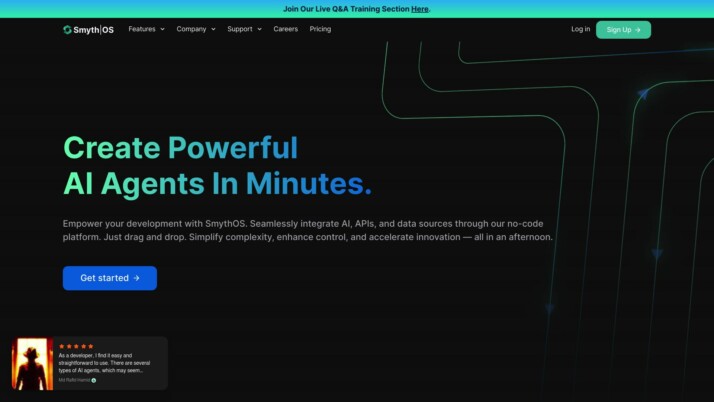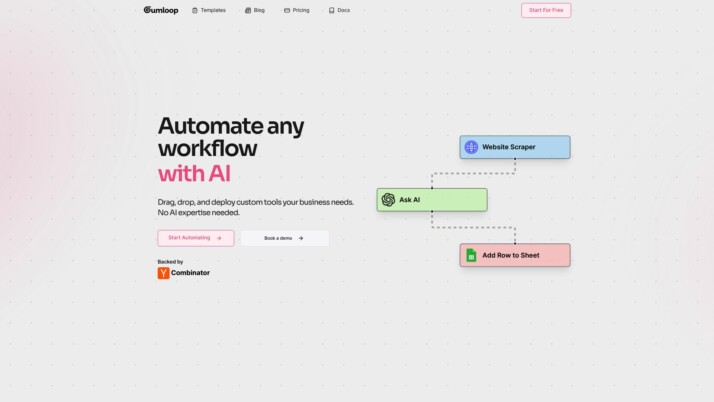SmythOS vs. AgentHub: Comprehensive Feature Comparison
As the demand for AI-driven solutions continues to surge, organizations across industries are seeking powerful yet accessible platforms to harness the potential of this transformative technology. Whether you’re a developer crafting cutting-edge applications, a business leader striving to optimize operations, or a researcher pushing the boundaries of innovation, this comprehensive guide aims to empower you in making informed decisions. We’ll delve into the feature sets, use cases, and utility of SmythOS vs. AgentHub, and other leading AI platforms, equipping you with the insights to unlock the full potential of AI integration within your workflows.
SmythOS Overview
SmythOS is a groundbreaking platform designed to streamline the creation and deployment of AI agents. Its unique features include a robust drag-and-drop interface, pre-built API integrations, and support for a vast array of AI models from different providers like OpenAI, Anthropic, and Hugging Face. Users can effortlessly design workflows that connect to various data sources, APIs, and AI models, making advanced AI functionalities accessible and straightforward.


At its core, SmythOS is a versatile AI operating system that enables users to create, deploy, and manage AI agents quickly and efficiently. The platform supports the creation of APIs, chatbots, and other AI-driven applications with minimal effort, thanks to its drag-and-drop interface and extensive library of pre-built components and templates. With SmythOS, we aim to revolutionize the way businesses and individuals utilize AI, making the creation and deployment of AI agents 99% faster and more accessible than ever before.
With SmythOS, we aim to revolutionize the way businesses and individuals utilize AI, making the creation and deployment of AI agents 99% faster and more accessible than ever before.
AgentHub Overview
AgentHub is a cutting-edge no-code platform designed to empower businesses with AI automation. It offers a comprehensive suite of tools and features that simplify the creation, deployment, and management of AI-powered workflows. With AgentHub, users can leverage the power of AI without the need for coding expertise, thanks to its intuitive visual builder.
One of the standout features of AgentHub is its collection of pre-optimized agents, meticulously crafted to tackle specific tasks seamlessly. These agents can handle a wide range of business processes, from lead generation and client management to marketing automation and transaction management. By combining these agents within customizable workflows, businesses can automate complex operations, streamlining their productivity and efficiency.


AgentHub’s vision is to democratize AI automation, making it accessible to businesses of all sizes and across various industries. The platform’s integration capabilities allow for seamless connectivity with popular software platforms, enhancing its flexibility and applicability. Whether it’s automating sales processes, optimizing HR workflows, or streamlining financial reporting, AgentHub empowers users to harness the power of AI for a multitude of use cases.
Feature Comparison
SmythOS presents a comprehensive and feature-rich platform for creating and deploying AI agents, offering a wide array of capabilities that set it apart from AgentHub. While AgentHub excels in providing pre-optimized agents and no-code automation workflows, SmythOS distinguishes itself with advanced features and an extensive integration ecosystem.
In terms of core features, both platforms support AI agents, hosted environments, visual builders, and no-code editors. However, SmythOS offers more robust capabilities, including multimodal agents, enhanced memory and context management, and stronger support for explainability and debugging tools. Additionally, SmythOS enables multi-agent collaboration, allowing teams of AI agents to work together seamlessly on complex tasks.
SmythOS distinguishes itself with advanced features and an extensive integration ecosystem, offering more robust capabilities compared to AgentHub.
When it comes to security, SmythOS provides a more comprehensive suite of features. It supports constrained alignment to ensure agents operate within intended boundaries, data encryption for enhanced data protection, OAuth for secure integrations, and IP control for granular access management. AgentHub, on the other hand, lacks some of these advanced security measures.
In the components category, SmythOS shines with its integration of various foundation AI models, including those from OpenAI, Anthropic, and Hugging Face. It also supports Zapier APIs and classifiers for data categorization. AgentHub, however, lacks support for these essential components, potentially limiting its versatility and customization options.
SmythOS also excels in deployment options and data lake support. It allows for seamless deployment as APIs, webhooks, site chats, and even as ChatGPT plugins or Alexa skills. Additionally, it provides robust data lake support, including hosted vector databases, sitemap crawlers, YouTube transcript crawlers, and support for various file formats like PDFs and Word documents. AgentHub’s deployment options and data lake support seem more limited in comparison.
| SmythOS | AgentHub | |
|---|---|---|
| CORE FEATURES | ||
| Multimodal | ✅ | ❌ |
| SECURITY | ||
| Data Encryption | ✅ | ❌ |
| OAuth | ✅ | ❌ |
| IP Control | ✅ | ❌ |
| COMPONENTS | ||
| Foundation AIs | ✅ | ❌ |
| Huggingface AIs | ✅ | ❌ |
| Zapier APIs | ✅ | ❌ |
| Classifiers | ✅ | ❌ |
| DEPLOYMENT OPTIONS | ||
| Staging Domains | ✅ | ❌ |
| Production Domains | ✅ | ❌ |
| API Authentication (OAuth + Key) | ✅ | ❌ |
| Deploy as Site Chat | ✅ | ❌ |
| Deploy as GPT | ✅ | ❌ |
| DATA LAKE SUPPORT | ||
| Hosted Vector Database | ✅ | ❌ |
| Sitemap Crawler | ✅ | ❌ |
| YouTube Transcript Crawler | ✅ | ❌ |
| PDF Support | ✅ | ❌ |
| Word .doc File Support | ✅ | ❌ |
| TXT File Support | ✅ | ❌ |
Overall, while AgentHub offers a streamlined no-code platform for automating specific business processes, SmythOS emerges as a more comprehensive and versatile solution for building, deploying, and managing AI agents across a wide range of use cases. Its extensive feature set, advanced security measures, and robust integration capabilities make it a compelling choice for organizations seeking to leverage the full potential of AI in their workflows.
Conclusion
SmythOS stands out as a comprehensive and versatile platform that empowers users to harness the full potential of AI across a wide range of applications. With its intuitive drag-and-drop interface, extensive integration ecosystem, and support for a vast array of AI models, SmythOS streamlines the creation and deployment of AI agents like never before.
SmythOS empowers businesses and individuals to automate complex workflows and unlock new levels of productivity.
At its core, SmythOS is an AI operating system designed to accelerate innovation and drive efficiency. By enabling multi-agent collaboration, advanced problem-solving capabilities, and seamless integration with various data sources, APIs, and AI models, the platform empowers businesses and individuals to automate complex workflows and unlock new levels of productivity.
With SmythOS, you can effortlessly build and deploy AI agents as APIs, webhooks, site chats, or even as ChatGPT plugins or Alexa skills. The platform’s robust security features, including constrained alignment, data encryption, and OAuth support, ensure your AI solutions operate within intended boundaries while maintaining data integrity.
Whether you’re a developer seeking to build cutting-edge AI applications, a business leader focused on optimizing operations, or a researcher exploring the frontiers of AI, SmythOS provides the tools and resources to bring your ideas to life. Explore the SmythOS agent templates to kickstart your AI journey, or create a free account to experience the power of SmythOS firsthand. With its comprehensive documentation and versatile deployment options, SmythOS empowers you to seamlessly integrate AI into your existing workflows and drive innovation across your organization.
Last updated:
Disclaimer: The information presented in this article is for general informational purposes only and is provided as is. While we strive to keep the content up-to-date and accurate, we make no representations or warranties of any kind, express or implied, about the completeness, accuracy, reliability, suitability, or availability of the information contained in this article.
Any reliance you place on such information is strictly at your own risk. We reserve the right to make additions, deletions, or modifications to the contents of this article at any time without prior notice.
In no event will we be liable for any loss or damage including without limitation, indirect or consequential loss or damage, or any loss or damage whatsoever arising from loss of data, profits, or any other loss not specified herein arising out of, or in connection with, the use of this article.
Despite our best efforts, this article may contain oversights, errors, or omissions. If you notice any inaccuracies or have concerns about the content, please report them through our content feedback form. Your input helps us maintain the quality and reliability of our information.
